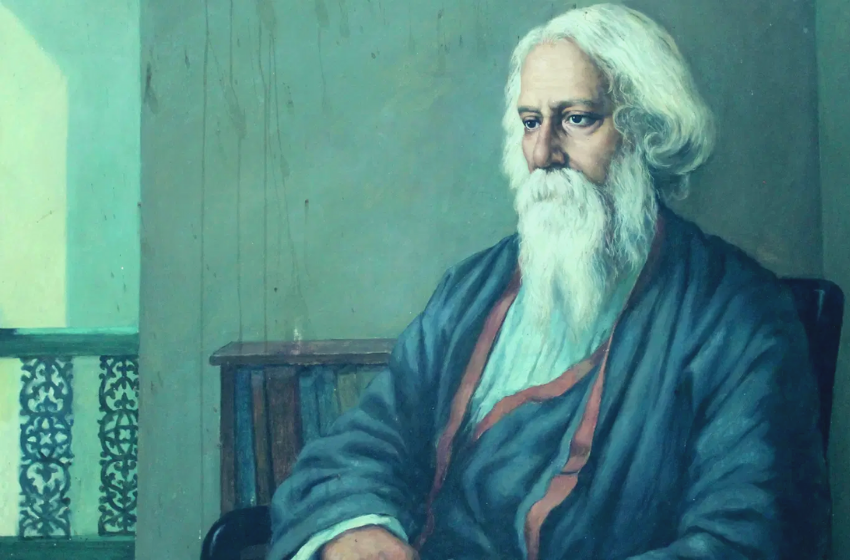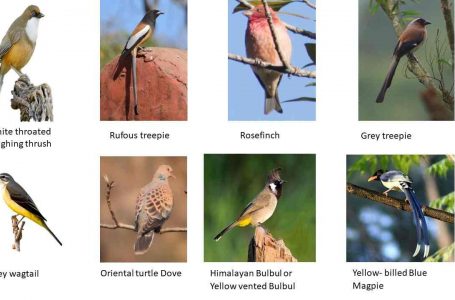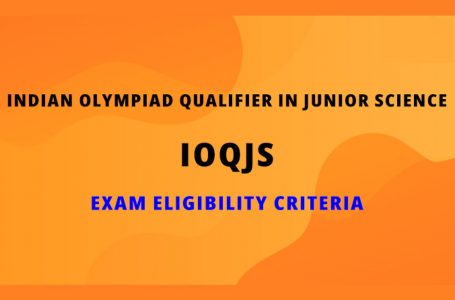Rabindranath Tagore – An Indian Polymath

Rabindranath Tagore was born on 7th May 1861. He was a great Indian polymath-poet, painter, philosopher, social reformer, playwright as well as composer. Tagore mostly avoided classroom schooling in childhood and preferred to roam on the family visited in Bolpur and Panihati. He used to take tuitions of swimming in the Ganges or trekking through the hills, gymnastics, and practicing wrestling and judo from his brother Hemendranath, he had also learned his favorite subject which was English, mathematics, history and geography, drawing, literature, Sanskrit and anatomy. At the age of eleven, he and his father left Calcutta for several months for an India tour. In this traveling period, Tagore used to study astronomy, modern science, Sanskrit, and history and also read biographies and examined the Kalidasa which was the classical poetry.
Table of Contents
Family background of Rabindranath Tagore
His family belongs to Rathi Brahmins and basically, they belonged to a village named Kush which is in West Bengal (Burdwan). Khushari was the original name of the Tagores. The name of the father of Rabindranath Tagore was Debendranath Tagore and his mother was Sarada Devi. He was the youngest child among the 13 surviving siblings and his nickname was Rabi. His father was almost on the work tours widely and his mother died early in his childhood and he was raised mostly by servants. The eldest brother of the Tagore was Dwijendranath Tagore who was a poet and philosopher, another brother was Satyendranath who was the first Indian to be appointed as the elite and formerly all-European Indian Civil Service and the third brother was Jyotindranath who was a musician, copyright, and composer as well and on the other hand, his sister became the great novelist. Besides this, the wife of Jyotindranath, Kadambari Devi who was slightly younger than Rabindranath was such a powerful influence, and the dear friend of the Tagore and his wife’s name was Mrinalini Devi, and belong to Phultala village in Jessor District OF Bengal. She was a Translator. She gave birth to her first girl child on 25th October 1886 and named her Madhurilata and later nicknamed Bela. Then in the year 1888, she gave birth to a son named Rathindranath, and later in the year 1891 she again gave birth to a daughter and named her Renuka, and after three years she gave birth to another daughter, Mira. The youngest child of Rabindranath was born in the year 1896 who was named Samindranath. The Rabindranath married off her daughter Bela on 15th June 1901 and married off her another daughter Renuka on 9th August 1901. However, in the year 1902, the wife of Tagore was fell seriously ill as the doctors were failed to diagnose her disease and on the night of the 23rd November, she was died and left Tagore profoundly in distress for years.
List of Rabindranath Tagore Works
Rabindranath was mostly known for his poetry as he had written many novels, short stories, dramas, essays, travelogues, and thousands of songs. The rhythmic, optimistic, and lyrical nature which was mostly borrowed from the real-life of the people was frequently noted. He had written many autobiographies. When he was just twenty, he wrote his first drama named Valmiki Pratibha and in 1877 he began his career in short stories when he was only sixteen years old. He had also written eight novels and four novellas and was awarded the Nobel prize in the year 1913 in literature internationally for the best collection of poetry, Gitanjali. His work was almost done in the Bengali language but later on, the translation is found by the project of Gutenberg and some other sources. He was also a composer of about 2,230 songs and at the age of sixty, he grew his interest in painting and held many successful exhibitions. In Paris, he made a debut appearance by the artists met in South of France for his encouragement. He had an artist’s eye and there are 102 collections of his masterpieces in India’s National Gallery of Modern Art.
On the other hand, he had played a crucial role in Politics as well he had supported Indian Nationalists as opposing Imperilialism at the age of twenty. He also lampooned the Swadeshi Movement. He also rebelled against the nationalist forms of Independence and also wanted India’s right to Independence. He had also written songs to lionize the movement of India’s Independence. He had also played a massive role in resolving the dispute between Gandhi and Ambedkar for the issue of separate electorates for the untouchables. Moreover, in the year 1919 in response to the Jallianwala Bagh Massacre, he renounced his knighthood by writing the repudiation letter to the Viceroy, Lord Chelmsford.
The list of original poetry in Bengali from Tagore is as follows:
| Year | Poetry | Translated Title |
| 1884 | Bhanusimha Thakurer Padavali | Bhanusimha Thakur |
| 1890 | Manasi | The Ideal One |
| 1894 | Sonar Tari | The Golden Boat |
| 1910 | Gitanjali | Song Offerings |
| 1916 | Balaka | The Flight of Cranes |
The list of original dramas in Bengali of Tagore is shown below in the table:
| Year | Dramas | Translated Title |
| 1881 | Valmiki- Pratibha | The Genius of Valmiki |
| 1882 | Kal-Marigaya | The Fatal Hunt |
| 1888 | Mayar Khela | The Play of Illusion |
| 1890 | Visarjan | The Sacrifice |
| 1892 | Chitrangada | Chitrangada |
| 1910 | Raja | The King of the Dark Chamber |
| 1912 | Dak Ghar | The Post Office |
| 1912 | Achalyatan | The Immovable |
| 1922 | Muktadhara | The Waterfall |
| 1926 | Raktakarabi | Red Oleanders |
| 1933 | Chandalika | The Untouchable Girl |
The list of some famous translated work of Tagore is as under:
- 1914 – Chitra.
- 1913 – The Cresent Moon.
- 1913 – The Gardener.
- 1922 – Creativity Unit.
- 1917 – The Cycle of spring.
- 1928 – Fireflies.
- 1916 – Fruit Gathering.
- 1916 – The Fugitive.
- 1920 – Glimpses of Bengal.
- 1921 – The Home & the World.
- 1916 – The Hungry Stone.
- 1991 – I Won’t Let You Go.
- 1914 – The King of the Dark Chamber.
- 2003 – The Lover of God.
- 1943 – The Boyhood Days.
- 1917 – Nationalism.
- 1915 – Song of Kabir.
- 1916 – The Spirit of Japan.
- 1916 – Stray Birds.
- 1913 – Vocation.
- 1918 – Stories from Tagore.
- 1921 – The Wreck.
Nobel Prize was Awarded to Rabindranath Tagore
Rabindranath Tagore was awarded the Nobel Prize in the year 1913 because of his beautiful and profound communication skills which expressed his poetic thoughts in his own words and for the literature of the West.
However, on 25th March 2004, his prize was somehow stolen from the Visva-Bharti University along with other belongings but on 7th December 2004, two replicas Nobel Prize was made to present Tagore. One was made of gold from the Swadesi Academy and the other was made of bronze from the Visva-Bharti University.
Best 10 quotes of Rabindranath Tagore
- Clouds come floating into my life, no longer to carry rain or usher storms but to add color to my sunset sky.
- I slept and dream that life was a joy. I awoke and saw that life was service. I acted and behold, service was a joy.
- Faith is the bird that feels the light when the dawn is still dark.
- You can’t cross the sea merely by standing and staring at the water.
- The butterfly counts not months but moments and has time enough.
- Let your life lightly dance on the edges of Time like dew on the tip of a leaf.
- Death is not extinguishing the light, it is only putting out the lamp because the dawn has come.
- Every child comes with the message that God is not yet discouraged of men.
- Beauty is the truth’s smile when she beholds her face in a perfect mirror.
- Trees are the earth’s endless support to the listening heaven.
Frequently Asked Questions
Q1. Who wrote the National Anthem of India?
Ans. Rabindranath Tagore had written the National Anthem of India “Jana Gana Mana” with the length of approximately 52 seconds after India got independence at the year 1947.
Q2. List some historical museum which was made in the memory of Rabindranath Tagore.
Ans. There are 8 historical museums made in the memory of Rabindranath Tagore from which 5 are in Bangladesh and the other 3 are in India. The list of these museums is listed under.
- Rabindra Museum – Mungpoo, India.
- Rabindra Bhavan Museum – Shantiniketan, India.
- Rabindra Bharti Museum – Joransanko Thakur Bari, India.
- Tagore Memorial Museum – Shilaidaha kuthibadi, Bangladesh.
- Rabindra Memorial Museum – Shahzadpur Kachharibari, Bangladesh.
- Patisar Rabindra Kacharibari – Patisar, Atrai, Naogaon, Bangladesh.
- Pithavoge Rabindra Memorial Complex – Pithavoge, Rupsha, Khulna, Bangladesh.
- Rabindra Complex – Phultala, Upazila, Khulna, Bangladesh.
Q3. Which novels and short stories of Rabindranath Tagore were adopted in Cinema and Television?
Ans. The list of some novels and short stories of Rabindranath Tagore which was adopted in Cinema and Television are:
- In the year 1932, the only film directed by Tagore was Natir Putra.
- In 1932, the novel inspired by Tagore, Gora was filmed and directed by Naresh Mitra.
- In 1957, Kabuli Wala was directed by Tapan Sinha.
- In 1961, Teen Kanya was directed by Satyajit Ray.
- In 2015, the Television serial was released by Anurag Basu as Stories by Rabindranath Tagore.
Q4. In which poem Rabindranath Tagore wins the Nobel Prize?
Ans. Rabindranath wins the Nobel Prize from the Gitanjali, Tagore’s best-known collection of poetry.
Q5. In which year the Rabindranath Tagore died?
Ans. Rabindranath Tagore died on 7th August 1941 at Jorasanko Thakurbari, Kolkata.





